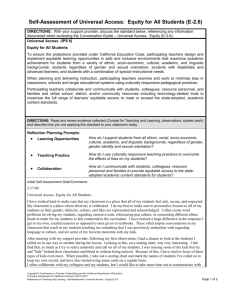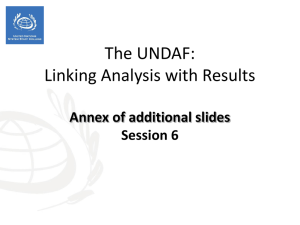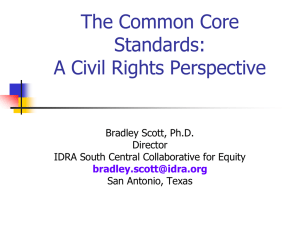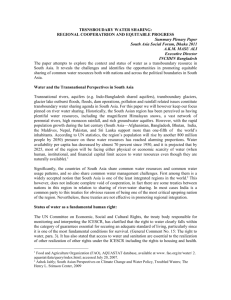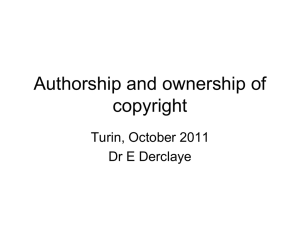Part I - Equitable Proprietary Interests
advertisement
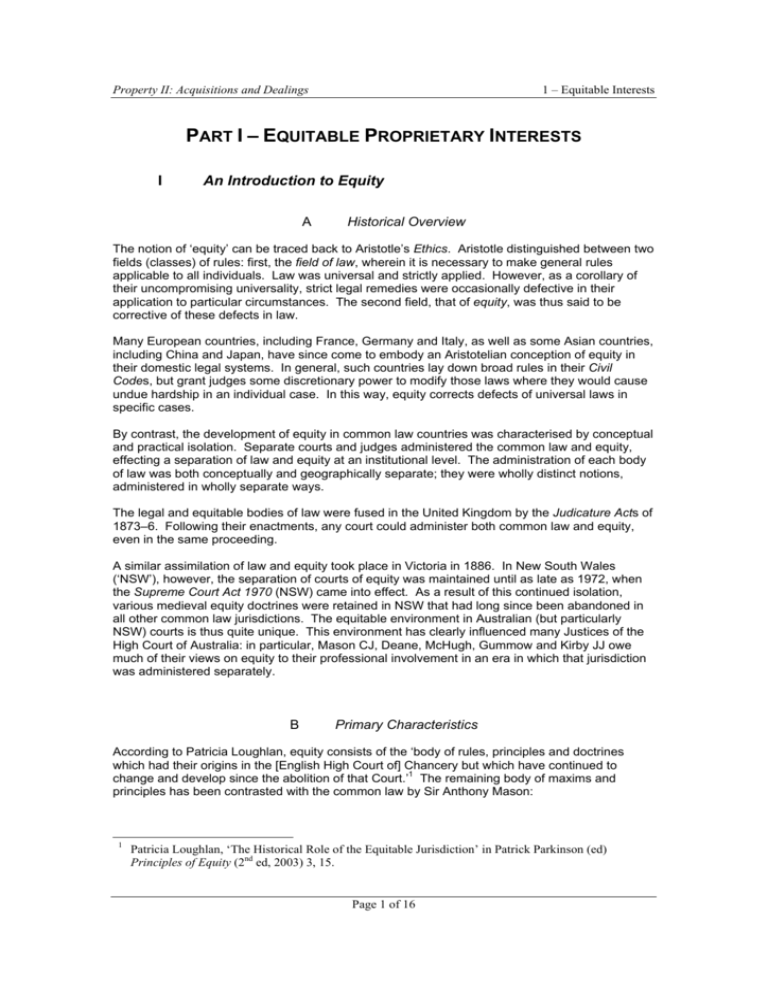
Property II: Acquisitions and Dealings
1 – Equitable Interests
PART I – EQUITABLE PROPRIETARY INTERESTS
I
An Introduction to Equity
A
Historical Overview
The notion of ‘equity’ can be traced back to Aristotle’s Ethics. Aristotle distinguished between two
fields (classes) of rules: first, the field of law, wherein it is necessary to make general rules
applicable to all individuals. Law was universal and strictly applied. However, as a corollary of
their uncompromising universality, strict legal remedies were occasionally defective in their
application to particular circumstances. The second field, that of equity, was thus said to be
corrective of these defects in law.
Many European countries, including France, Germany and Italy, as well as some Asian countries,
including China and Japan, have since come to embody an Aristotelian conception of equity in
their domestic legal systems. In general, such countries lay down broad rules in their Civil
Codes, but grant judges some discretionary power to modify those laws where they would cause
undue hardship in an individual case. In this way, equity corrects defects of universal laws in
specific cases.
By contrast, the development of equity in common law countries was characterised by conceptual
and practical isolation. Separate courts and judges administered the common law and equity,
effecting a separation of law and equity at an institutional level. The administration of each body
of law was both conceptually and geographically separate; they were wholly distinct notions,
administered in wholly separate ways.
The legal and equitable bodies of law were fused in the United Kingdom by the Judicature Acts of
1873–6. Following their enactments, any court could administer both common law and equity,
even in the same proceeding.
A similar assimilation of law and equity took place in Victoria in 1886. In New South Wales
(‘NSW’), however, the separation of courts of equity was maintained until as late as 1972, when
the Supreme Court Act 1970 (NSW) came into effect. As a result of this continued isolation,
various medieval equity doctrines were retained in NSW that had long since been abandoned in
all other common law jurisdictions. The equitable environment in Australian (but particularly
NSW) courts is thus quite unique. This environment has clearly influenced many Justices of the
High Court of Australia: in particular, Mason CJ, Deane, McHugh, Gummow and Kirby JJ owe
much of their views on equity to their professional involvement in an era in which that jurisdiction
was administered separately.
B
Primary Characteristics
According to Patricia Loughlan, equity consists of the ‘body of rules, principles and doctrines
which had their origins in the [English High Court of] Chancery but which have continued to
1
change and develop since the abolition of that Court.’ The remaining body of maxims and
principles has been contrasted with the common law by Sir Anthony Mason:
1
Patricia Loughlan, ‘The Historical Role of the Equitable Jurisdiction’ in Patrick Parkinson (ed)
Principles of Equity (2nd ed, 2003) 3, 15.
Page 1 of 16
Property II: Acquisitions and Dealings
1 – Equitable Interests
the ecclesiastical natural law foundations of equity, its concerns with standards of
conscience, fairness, equality and its protection of relationships of trust and confidence,
as well as its discretionary approach to the grant of relief, stand in marked contrast to the
more rigid formulae applies by the common law and equip it better to meet the needs of
the type of liberal democratic society which has evolved in the twentieth century.2
Writing in the early twentieth century, Maitland argued that was then very little, if anything, to
distinguish the jurisdiction of equity from that of the common law: ‘what it is that marks [equitable
rules] off from all other rules administered by our courts [is] nothing but this, that these rules were
3
until lately administered, and administered only, by our courts of equity.’ Maitland described the
effect upon the common law as ‘equitable glosses’.
Nevertheless, three basic — but distinct — characteristics of equity may today be identified:
1
Equitable doctrines are based on the idea of conscience
Equity will not permit the unconscionable enforcement of a legal right. The notion of
‘unconscionability’ is one aspect of this characteristic, and arises most frequently in contract law
to set aside contracts, gifts or wills where it would be unconscionable to insist upon the
enforcement of legal rights they confer.
Examples of equitable unconscionability:
•
•
•
The Amadio doctrine (protecting entrants to a contract of guarantee from unconscionable
conduct on the part of the mortgagor);
Wife’s equity is another application of this principle (equity will not permit a common law
contract of guarantee to be enforced if it would be unconscionable to do so): Garcia v
National Australia Bank;
The setting aside of penalty clauses and relief from forfeiture of equitable interests
constitute further examples.
Conscience arises frequently in the law of property. Several manifestations of conscience in
property law may be identified:
•
Constructive trusts
A court will not allow legal title to property to be relied upon when it would be
unconscionable to do so in equity (Muschinski v Dodds; Baumgartner v Baumgartner);
•
The doctrine of notice
A legal proprietary interest is normally enforceable ‘against all the world’. However, an
equitable interest in land is only enforceable against persons who are not good faith
purchasers of a legal estate in that land who have no notice (knowledge) of the existence
of the equitable property interest.
For example, where a landlord has granted an equitable lease on a property, if that
property is subsequently sold, the third party purchaser will not be bound by the lessee’s
interest if they are a good faith purchaser who lacks notice of the existence of the
tenant’s equitable interest in the land
As a result of the doctrine of notice, equitable interests are more delicate than their legal
counterparts. While legal interests are enforceable even where parties are not aware of them,
2
3
Sir Anthony Mason, ‘The Place of Equity and Equitable Doctrines in the Contemporary Common law
World: An Australian Perspective’ in D Waters (ed), Equity, Fiduciaries and Trusts (1993) 1, 5.
J Brunyate (ed), Maitland’s Equity (2nd ed, 1936) 3.
Page 2 of 16
Property II: Acquisitions and Dealings
1 – Equitable Interests
equitable interests will not be valid as against a purchaser of property who lacks knowledge of
their existence.
2
Equity is informal
The common law is typically a formal jurisdiction. Historically, legal interests in land had to be
conveyed by deed and transactions were marked by ritual and formality. Even today, a
registered instrument of transfer is required to effect a valid transfer of land: Transfer of Land Act
1958 (Vic) s 45.
Equity, by contrast, is an informal jurisdiction. Although not all statements or conduct will create
an equitable interest, their creation requires no deed. Often interests will be recognised in spite
of the absence of supporting documentation (such as registration). An example of this informality
is provided by the doctrine of equitable estoppel. Where a defendant induces an assumption in a
plaintiff, and that plaintiff acts to his detriment in reasonable reliance upon that assumption, he
may be entitled to an equitable proprietary interest in support of the mistaken assumption.
3
The award of damages is not an available remedy in equity
An equitable right will generally not confer an associated right to damages. Instead, various
equitable remedies exist, including the following:
•
•
•
Specific performance (of a contract or other instrument);
Injunction (preventing or compelling something); and
Account of profits (a return of ill-gotten gains)
Account of profits may be sought where a defendant reaps profits from their wrongdoing. If
successful, the defendant must pay their unjust gains to the plaintiff. Note, however, that this is
not a payment of damages for loss, but a return of ill-gotten gains or profits (ill-gotten because
they breach an equitable right or interest).
4
Equity is materialistic
An examination of equitable principles — particularly in the domestic context — might well lead
one to ask: ‘how materialistic is equity?’. Equity appears to award proprietary interests to parties
who have improved or added financially to property (whether by purchasing it, or performing work
to improve it).
The comment has been made that equity demands the ‘solid tug of money’ before an equitable
interest will be imposed. The issue of the extent to which non-financial contributions — such as
child-rearing, palliative care or domestic activities — entitle the contributor to an equitable interest
as constructive beneficiary remains unresolved (much to the ire of feminist legal critics).
5
Equity is dominated by maxims
Equitable maxims are formulaic statements of broad normative principles which broadly
characterise the development of equitable rules and doctrines. They include:
•
•
•
Equity looks on as done that which ought to be done;
Equity follows the law;
He who comes into equity must come with clean hands;
Page 3 of 16
Property II: Acquisitions and Dealings
•
•
•
•
•
•
•
•
•
•
1 – Equitable Interests
He who seeks equity must do equity;
Equity does not allow a statute to be made an instrument of fraud;
Equality is equity;
Equity acts in personam;
Equity will not assist a volunteer;
Equity looks to intent not form;
Equity will not suffer a wrong to be without a remedy;
Where the equities are equal, the law prevails;
Where the equities are equal, the first in time prevails; and
Equity aids the diligent not the tardy.
C
1
Further Examples of Equity in Property Law
Express trusts
An express trust arises where a settlor (a legal owner of property) declares certain property (real
or personal) to be held on trust for another. The trust is arguably the most distinctive equitable
structure, and is highly flexible. It effectively creates two divisions in ownership:
•
•
First, the legal distinction between legal and equitable interests in property
o Trustees have legal ownership, but the beneficiary has an equitable interest in
the same property
o That is, one piece of land forms the subject of two proprietary rights
Second, a functional division between trustee (the manager of property) and beneficiary
(the enjoyer of property)
o The express trust is a functional method of separating the management of
property from its enjoyment
A trustee is under a duty to maintain, insure, invest, or otherwise protect the property, and may be
liable for breach of trust. A beneficiary is entitled to enjoyment of the property held on trust,
income or proceeds from its use or rental, occupation (in the case land), and any other benefits
accruing from its existence. The beneficiary’s interest is enforceable against anyone except a
good faith purchaser without notice.
Express trusts are used for various familial, commercial, and welfare purposes. The family trust,
for example, is a common method of holding family money ‘on trust’ for subsequent generations.
It provides a legal mechanism for the intergenerational transfer of wealth. Superannuation is also
structured using trusts; the Superannuation Annual Supervision Act 1993 (Cth) requires adoption
of a trust structure by superannuation funds.
Other examples of trusts:
•
•
•
Charities: often structured as trusts
Melbourne University: trustee for various scholarship and development funds
Associations and clubs: the president, secretary or treasurer are often trustees who hold
the club’s assets on trust for individual members
As evidenced by the range of applications to which trusts are put, the express trust is one of the
most flexible equitable devices yet developed. However, the concept of an express trust is only a
very recent introduction to many civil law jurisdictions. The mechanism has often been
introduced for commercial reasons, as in Japan and China, where it took place in 2000 (and
puzzlingly, in the latter country, in the absence of any private property law).
Page 4 of 16
Property II: Acquisitions and Dealings
2
1 – Equitable Interests
Resulting and constructive trusts
The resulting and constructive trusts are two are classes of equitable trust. Like the express
trust, both separate legal and equitable ownership of a proprietary interest. Though they are
different concepts, both resulting and constructive trusts have one commonality; namely, they are
both imposed by the operation of law (and not created voluntarily by an individual settlor).
Courts will often impose trusteeship on an unwilling defendant. For example, a court order might
deem a defendant trustee for the plaintiff’s damages in a civil action.
(a)
Resulting trusts
A resulting trust arises where title to a property is held by someone other than the person who
paid for it, or in proportions different to those in which the property was acquired. In such
circumstances, the legal owner is said to hold the property on trust for the purchaser. Ownership
reverts to the person who paid money for the property.
For example, if a purchaser of land registers the title to that land in another’s name, that other
becomes the legal owner. However, in equity, the owner’s registered interest in the land ‘springs
backwards’ to the purchaser in equity. This fact, coupled with an understanding of the etymology
of the word ‘resulting’, explains the name of the trust: ‘resulting’ derives from the Latin re salieri
(meaning, ‘to jump’ or ‘to spring backwards’).
Resulting trusts most often arise in the context of marriage, where it is common for a husband
and wife to be joint legal owners but for equitable title to be held on trust for the husband (or
person who paid money for it).
Essentially, this equitable mechanism stems from the first characteristic of equity identified above.
According to the conscience doctrine, property should belong in equity to those who paid for it.
The presumption that property is held on trust of the purchaser is, however, rebuttable by
evidence that the purchaser intended both parties to have title to the property. In some
circumstances, a counter-presumption (called the ‘presumption of advancement’) automatically
arises to return the onus to the purchaser to demonstrate that the property was in fact transferred
with the intention to create a trust. These situations are discussed in greater detail in Part IV
below.
(b)
Constructive trusts
When a constructive trust is deemed to arise, a court holds the relevant party as trustee
regardless of the parties’ actual intentions. The equitable effect thus stems not from the parties
but from a court order or decree. Constructive trusts are typically imposed in relation to de facto
property disputes (where the issue is whether a party has an equitable proprietary interest as
against a bank or creditor).
Again, this is a conscience-based doctrine: courts will impose a constructive trust where it would
be unconscionable or inequitable for the legal owner to assert a full legal title.
3
Equitable leases
Equitable leases provide an example of the informality of equity. At common law, leases must be
executed by deed (subject, of course, to a statutory exception that leases three years or less
need not be executed by deed). By contrast, equitable leases are enforceable even absent a
deed. The only requirement is that that one of the following criteria is satisfied:
Page 5 of 16
Property II: Acquisitions and Dealings
•
•
1 – Equitable Interests
The lease is in writing and signed by defendant (party to be charged); or
The doctrine of part-performance (an equitable doctrine) applies.
If part-performance has taken place, an equitable lease can be totally oral. This will occur if the
plaintiff has partly performed the contract of lease. In such cases, the whole lease becomes
enforceable. An example of this is when a tenant goes into occupation and pays rent on a
regular basis.
There are two important limitations placed upon equitable leases:
1
The doctrine of notice
Good faith purchasers of land subject to an equitable lease are not bound by the terms of
the lease. Although a tenant may have an action against the former landlord for
disposing of the property inconsistently with the lease, the tenancy itself would not be
binding upon the new legal owner.
2
Remedies
If a tenant wants to enforce the lease, their remedy is limited to specific performance (and
not damages). However, because specific performance is a discretionary remedy, a
tenant who has not complied with the terms or covenants of the lease may not be entitled
to specific performance. This limitation is based on the ‘clean hands doctrine’: a plaintiff
must come to equity with clean hands (moral integrity).
4
Equitable mortgages
Equitable mortgages are, like legal mortgages, a kind of security interest over a specific object of
property. They also provide another example of equity acting informally to create enforceable
legal relations.
At common law, a deed was traditionally required to create a mortgage. This was a complicated,
formal procedure. Today, common law mortgages must be registered according to a formal
statutory procedure prescribed by s 74 of the Transfer of Land Act 1958 (Vic). In equity, deposit
of the title deeds with the mortgagor (lender) by the mortgagee (borrower) is sufficient to create
an equitable mortgage. In this way, it is possible to avoid the documentation requirements
entirely by leaving title as security with the lender; this has led to the creation of so-called ‘no-doc’
mortgages.
D
1
Interactions between Formal and Informal Interests in Land
Do we any longer need separate common law and equitable estates and interests?
There is presently much debate about whether the two systems of private law should be fused as
one. In theory, the ratio decidendi of a case should be identifiable by reference to solely
equitable or common law principles. ‘Fusion fallacies’ occur when judges intermingle principles
from both jurisdictions, leading to what some describe as an unsound result.4
However, one possible argument for fusing the common law and equity in substance as well as
procedure could stem from there no longer being any need for ‘a distinctive equity
5
jurisprudence’, as would be the case if the common law no longer requires equitable correction.
4
5
See, eg, Meagher, Gummow and Lehane, Equity: Doctrines and Remedies (3rd ed, 1992) 47.
Loughlan, above n 1, 24.
Page 6 of 16
Property II: Acquisitions and Dealings
1 – Equitable Interests
The extent to which this is so remains unclear, though the increasing fusion of equitable and
common law doctrines of estoppel seems to indicate some blurring of the lines.
2
Given that current conveyancing systems rely on computerised title registration, doesn't
the existence of informal equitable interests undermine the certainty provided by title
registration?
If an equitable interest can be created by informal processes (word of mouth, possession, etc) it
might be argued that this renders the status of all proprietary interests to some degree uncertain.
However, it is generally accepted that this uncertainty represents an acceptable compromise
between the injustices of general law indeterminacy and the rigidity of (and occasional unfairness
perpetrated by) indefeasibility of title.
Although various models for creating a registry of equitable interests have been proposed, they
are unlikely to be effective given the constructive and informal nature of many equitable interests,
registration of which would defeat the purpose for their existence.
Page 7 of 16
Property II: Acquisitions and Dealings
II
1 – Equitable Interests
Equitable Interests and the Torrens System
A
Historical Context
General issue: in an era of registered title and computerised information on title, to what extent
does the existence of informal (equitable) interests undermine the certainty of registered title?
The English law of property received at colonisation embodied feudal doctrines of tenure. Rather
than possessing allodial ownership of land itself, fee simple was said to be held of the Crown by
tenurial grant. Although it is undeniable that English property law has shaped the development of
Australia’s, to describe the present law of property in Australia as ‘largely derivative of’ English
law would be decidedly inaccurate.
Various species of property are unique to Australia, along with statutory mechanisms to regulate
their acquisition and dealings. For example, statutory tenures represent uniquely Australian
developments (see Wik; Wilson v Anderson). Strata title was first conceived and implemented in
the Australian jurisdictions. Native title — in the form in which it exists in Australia — is, though
influenced by the course taken in other common law jurisdictions, a fundamentally antipodean
concept. Because of these developments, Bradbrook, MacCallum and Moore argue that the
concepts of Australian property law as they stand today are ‘fundamentally different' from their
English counterparts and predecessors:
Australian real property law is peculiarly Australian and cannot properly be understood
unless it is recognised that its fundamental concepts are different from an English feudal
6
system.
7
Although the essential character of Australian real property law ‘is the subject of controversy’,
the Torrens system must unquestionably form its core element. Introduced to South Australia in
1854, the Torrens system of title by registration creates incidents of land ownership of a different
nature to those recognised under the English model. In England, existing paper title may be
registered for record-keeping purposes, but the legal title is already in existence. In Torrens
jurisdictions, however, title to land is itself derived from the act of registration:
The essence of Australian real property law is the Torrens system. This system should be
seen as changing the nature of interests in land. The system is one where title to land is
derived from registration- it is a system of title by registration and not one of registration
of title.8
Although, as some commentators suggest, much of Australia’s real property law is simply
adapted from received law, the Torrens system is a novel development.
That the law of property in Australia radically differs from that of England is hardly surprising.
Each jurisdiction has experienced vastly different social, economic and environmental conditions
th
since Australia’s federation in 1901. Even as early as the 19 century, a period of rapid
colonisation and inland expansion was beginning in Australia, the effect of which was to
precipitate development of unique statutory tenures and bureaucratic procedures for land title
registration. The move to a statutory system of title registration was not unique to Australia,
however. Similar developments took place in many common law countries during the latter half
th
of the 19 century (eg, Native Land Court, which was established in New Zealand in the 1860s).
6
See Adrian Bradbrook, Susan MacCallum and Anthony Moore, Australian Real Property Law
rd
(3 ed, 2002) 1. See further ibid 1–26.
7
Ibid 1.
8
Ibid.
Page 8 of 16
Property II: Acquisitions and Dealings
1 – Equitable Interests
Even those concepts and structures that were retained from England were recognised in a
transfigured form, largely as a result of the different registration procedures. For example, while
concepts of ‘title’ and ‘fee simple’ were inherited from England, the manner in which ‘registered
proprietors’ obtain title to an estate in fee simple (by registration) is a mechanism foreign to
English property law jurisprudence.
Land in Australia is thus held in a variety of ways. The many private interests are products of
statute, native title (supported by statute), common law, and equity. In addition, vast tracts of
Crown lands remain. Progressively more privately-held land has been brought within the Torrens
system since its inception, leaving only isolated regions of general law (‘old system’) title. These
two models of land title (general law land and Torrens) operate simultaneously and in concert
with statutory tenures over Crown land.
Lee Godden argues that Australian property law does, to some extent, remain coloured by
English property law concepts. In particular, Australian courts and legislatures have not
dispensed completely with the received law and its associated values and conceptual structures;
this is particularly so in the context of equity, where Australian property law remains strongly
influenced by English equitable doctrines.
By contrast, Brennan J in Mabo (No 2) v Queensland stated that ‘property [is] no longer a
prisoner of an Imperial history’. It is respectfully suggested that Australian property law remains,
in many respects, a prisoner of its historical development — particularly insofar as it incorporates
the English maxims of equity.
B
The Torrens System
The Torrens system is a legal mechanism for consolidating information about acquisitions and
dealings in land in a public register. Fundamental to the Torrens system is that a conclusive
register of proprietary interests in land is maintained by a registrar of land titles and made publicly
accessible. Under the Torrens system, title to land is granted through the act of registration.
Registration does not simply formalise and recognise an existing title; the legal title is itself
created upon registration.
Indefeasibility of title is also a hallmark of the Torrens system: unregistered interests will (in
general) be insufficient to defeat (take priority over) a registered legal proprietary interest.
Because the register is conclusive, registration confers an indefeasible title (subject to certain
exceptions).
The Torrens system was proposed by Sir Robert Torrens (though some debate surrounds the
true identity of its inventor) in 1854 and was then introduced into South Australia. It was designed
to be a more efficient, cheaper and reliable way to transfer land and ensure certainty of title. The
problems intrinsic to general law land titles were overcome by introducing:
•
Public title documents
A private system of title documents makes it difficult to trace back through a chain of title
to make sure that the current owner of land has a good root of title (and hence a certain,
unimpeachable title capable of sale)
o This was not as much of a problem in England, because land was typically
transferred within families
o However, there were several problems with the previous system of private titles:
Documents and deeds would go missing
Informal equitable interests weren’t recorded and could not be traced by
title deed
Page 9 of 16
Property II: Acquisitions and Dealings
1 – Equitable Interests
The doctrine of notice bound bona fide purchasers with knowledge of
prior equitable interests to continue to recognise those interests
•
Efficiency and reliability
The Torrens system was designed to be both more reliable and cheaper than the general
law system
o Tracing title chains was costly and labour-intensive
o Searches of the register can be conducted quickly and transactions easily noted
and recorded
•
Indefeasibility of title
The system abolished the doctrine of notice in favour of people who registered their
interests in the register
o Torrens effectively abolished the doctrine of notice from registered titles
o An entry onto the public register confers title to land; this title takes priority over
unregistered equitable interests
o Because registration of title was conclusive and indefeasible, there was no longer
any need to ‘look behind’ (discover the history of) a title purportedly held
The preamble to the Real Property Act 1857–8 (SA), the statute by which Torrens gave initial
form to his system, plainly indicates that he was inspired by dissatisfaction with the system of
legal and equitable estates and with the conveyancing complexities to which that division had
9
given rise.
The present system of title registration stands in stark contrast to the previous procedure for
transferring proprietary interests, which relied upon written deeds:
Historically the conveyancing process, the legal process by which interests in land are
transferred from one owner to another, principally operated through a contractual regime,
supported by the professional practices of solicitors that had developed over a long period of
10
time.
C
Formalities and Registered Interests
Critchley describes a formality as a legal requirement that a particular form be adopted for a
transaction to have the specified legal effect. Throughout history, property lawyers have insisted
upon various formalities in connection with transactions involving land. The process of land
transfer, in particular, was attended by a large degree of formality. The most prominent example
of such requirements is the Statute of Frauds and its role in medieval property law.
The formal nature of dealings with property arguably reflected the economic and cultural
importance of land in society. However, in adapting to different Australian legal and
environmental conditions, the formalities changed. As Pottage observes:
The public processes of land regulation and administration that so distinctly characterised
colonial Australia arose in response to the vast distances of the continent, the flux of land
ownership and the difficulties of land conveyance in a shifting and often newly arrived
society.11
9
Justice Gummow, ‘Equity and the Torrens System Register’ in David Grinlinton (ed), Torrens in
the Twenty-First Century (2003) 53.
10
Pottage, 376–7.
11
Ibid.
Page 10 of 16
Property II: Acquisitions and Dealings
1 – Equitable Interests
Pottage describes the former requirements for establishing proof of title under as ‘product[s] of a
12
private and self contained contractual process’. These formalities have been variously praised
and criticised:
Advantages of formalities
•
•
•
To vendor and purchaser
• Warns parties about the importance of the transaction
• Protects from duress or undue influence (writing, signature, witness, etc)
• Clarifies important terms
• Educative about legal effects
To third parties
• Registration enables enforcement of taxation
• Collection of data about property sales
• Public access to transactions which might adversely affect third parties
• Protection where no public access (arguably an informality: equitable doctrine of
innocent party)
To courts
• Evidentiary value
• Secondary evidence (about intention, notice, etc)
Disadvantages
•
•
•
•
•
Added transaction costs
• Perception that formalities exist to serve lawyers
• But: lower than costs of litigation/retransfer
Informal transactions fail
• Arguably not always a 'detriment'
Injustice may arise where parties don't understand or are ignorant of formalities, but want
the transaction to proceed
May be impossible or impracticable to comply with formalities
Undermines 'default' provisions and policy aims
Because the Torrens system also requires a certain (though ultimately lesser) degree of formality
(registration, written agreements, etc), there is still a role for equity to correct anomalies in land
transactions. As Barry v Heider illustrates, equitable doctrines are both retained by and
compatible with statutory systems of land registration, and are arguably capable of avoiding
injustice in individual cases.
D
Significance of the Torrens System
Sackville and Neave agree that the Torrens system ‘fundamentally changed the nature of real
property in the colony’:
In gauging how far the Torrens system moved from English doctrines we need to
consider the extent to which the operation of the Torrens statutory system of land title
registration remains subject to the influence and operation of English common law
property doctrines and other elements such as equity.13
12
13
Pottage, Originality of Registration, 383.
th
Sackville and Neave, Property Law: Cases and Materials (6 ed, 2002) 419.
Page 11 of 16
Property II: Acquisitions and Dealings
1 – Equitable Interests
Several issues arise in relation to the operation of a statutory system of land title registration:
•
The extent, if any, to which such a system recognises, or its operation affected by,
unregistered equitable interests, such as trusts
o ‘Informal interests’ give effect to principles of good conscience exist ‘outside’ the
Torrens register
o Because they derive from the behaviour and dealings of parties, and occasionally
from a court order, most equitable interests are not formally recorded on the
public register of land titles
•
The manner in which the system interacts with equity
o This requires consideration of how one system of laws interacts with another
o The interaction may be similar to that observed between tenure-based systems
of law and native title
Native title is the description given to the set of rights and interests
arising out of indigenous peoples’ prior occupation of Australia that the
common law is prepared to recognise and protect
It allows the two different systems of law to ‘converse’ in a particular way
(a ‘recognition space’, with the common law dominant)
Mabo (No 2) v Queensland effectively sets up a ‘priority’ system (ie, how
competing claims to land between settlers and indigenous groups will be
regulated)
The Native Title Act 1993 (Cth) developed the circumstances in which
one interest will prevail by means of the concept of extinguishment
The resulting species of rights was described in Commonwealth v
Yarmirr as ‘neither an institution of the common law nor a form of
common law tenure but it is recognised ... by the common law. There is,
therefore, an intersection of traditional laws and customs with the
common law’: at 120
o The resolution of disputes between equitable interests must also be considered
Legal v Legal
Legal v Equitable
Equitable v Equitable
Equitable v Mere Equity
E
Unregistered Interests
One of the primary issues associated with a land registration system is the extent to which
‘informal’ (unregistered) interests in land can be accommodated. To what extent can Torrens
system recognise equitable interests and give effect to dealings taking place outside the register?
The register is supposed to be conclusive, so what is the fate of informal transactions?
The Torrens system incorporates certain unregistered interests; however:
The only interests that can exist in relation to Torrens System land are those recognised
by the system. Nonetheless, the system does recognise interests that are not set out in
14
the central register so that there are both registered and unregistered interests.
Justice Gummow has made extra-curial statements to the effect that judicial interpretation of the
Torrens statute has subverted its original aims and policy. By ‘bending’ the statute to fit existing
legal rules and equitable principles, courts have undermined the certainty of the register by
14
Bradbrook, MacCallum and Moore, above n 6, 1–2.
Page 12 of 16
Property II: Acquisitions and Dealings
1 – Equitable Interests
15
affording too little scope for unregistered interests. According to Gummow J, such interests are
an inherent part of any system of title by registration [???]:
The great policy of the Shipping Acts was not the policy of the Torrens system — there
was nothing in the system which rendered it necessary that trusts not exist nor contracts
16
not be enforced.
Tension between the registered Torrens and unregistered equitable systems continues.
However, it seems clear that informal interests in and dealings with land can be accommodated
by the formal system for registration of title.
The ability to create and the validity of an equitable estate in land, the title to which is
under the Torrens system were fully established in Barry v Heider.17
As was noted above, the interaction between legal Torrens interests and informal equitable ones
is rather like that which takes place between native title rights and the common law. This
interaction concerns the intersection of two systems (one dominant: Torrens; one secondary:
equity). Interests must be recognised by the Torrens system; however, there are recognised
interests that are both registered and unregistered.
In essence, Torrens established a priority system and mechanisms for regulating disputes about
priorities. Thus, subject only to a few exceptions, registered title trumps equitable interests. The
Torrens system does recognise equitable interests in some circumstances, just like property law
recognises native title at certain intersection points. However, registered title will usually
‘extinguish’ an equitable interest.
The ways in which equity interacts with the Torrens system include:
•
•
•
•
•
The system of equitable estates and interests in relation to land
o Registered title usually trumps equitable title, but not always
o Where it would be ‘against conscience’ to rely on a formal title, such reliance will
be restrained by equity
o Adverse possession provides another example of a circumstance in which
registered title will be inferior to an unregistered adverse interest
Equitable remedies to aid enforcement of statutory prohibitions and protection of statutory
rights under the Torrens system
Declaratory and injunctive relief in relation to the powers of the land registrars
The caveat system
o Caveats afford equitable interests some degree of protection
o They are similar in effect to an injunction, and protect equitable interests by
preventing inconsistent treatment of the land subject to the caveat
o Caveats allows parties with unregistered interests to protect their interests until
formally recognised by the registrar
The exercise of the courts’ general jurisdiction to enforce common law rights and
equitable obligations and duties, by in personam remedies
15
Justice Gummow, above n 9, 54.
Ibid 53.
17
Ibid 54.
16
Page 13 of 16
Property II: Acquisitions and Dealings
E
1 – Equitable Interests
Exceptions to Indefeasibility
Fraud is one exception to indefeasibility of Torrens title. However, the notion of fraud has been
interpreted strictly so as to exclude ‘equitable fraud’ from the ambit of the statutory definition (see
below). The position of volunteers prior to registration is also considered below (see Corin v
Patton at 61–2: good title passes where the donor performs all steps reasonably required to effect
a transfer).
As Barry v Heider illustrates, equitable interests can be given effect to in the Torrens system,
provided they are recognised. Different answers are provided to the question of the source of this
recognition. The source is described by Griffith CJ as being legislative in nature, resting upon an
interpretation of the relevant statutory instrument. By contrast, Isaacs J turns to doctrines of
conscience to justify the continued recognition of equitable principles in a statutory environment.
Barry v Heider (1914) 19 CLR 197:
Facts:
• The appellant, Barry, transferred property to Schmidt; a memorandum of transfer was
signed, 1200 pounds paid and receipt acknowledged; a solicitor witnessed the
transaction and a formal contract of sale made and signed
o The land included was only a portion of the land held under the appellant's title
(a subdivision)
• Schmidt obtains a mortgage in favour of Heider to execute transfer of the property, and
the payment is made on 19 October
o Although a new certificate of title showing the subdivision was yet to be delivered
o At this stage, no certificates of title are held by Barry
• Schmidt takes out a mortgage on the land from Heider to the value of 800 pounds; the
memorandum of mortgage is executed on faith of the signed contract of sale and a
"Deed of the land being balance certificate of title" (representing that, but for registration,
Schmidt is the owner of the mortgaged land)
o Schmidt takes out a second mortgage of 400 pounds from Gale
o These equitable mortgages are unregistered; mortgagee still isn't registered
proprietor when obtained
• None of the documents of transfer or mortgage were registered until 20 December due to
a delay caused by an adjustment of the alignment of streets fronting onto the property
o The land is actually worth 4000 pounds
• On 20 December, Barry sues Schmidt, alleging that the original sale was obtained by a
false and fraudulent representation of Schmidt, and claiming that the sale was for 4000
pounds; he seeks an injunction to prevent registration of the transfer and a declaration
that it is void ab initio
o Because Barry has a vendor's lien, he has an equitable interest in receiving
payment under the terms of the contract of sale
o Cf purchaser's lien: he has an equitable interest in the contract of sale being
specifically performed
• The trial judge, Simpson CJ in Eq, declared the transfer void and ordered Schmidt to
deliver it for cancellation
o However, Barry's interest in the land remains subject to the interests of the
mortgagors
o The mortgagors, including Heider, are joint in subsequent proceedings with
Schmidt; they argue that Barry should be estopped from denying the validity of
the 19 October transfer
• The Court holds that the creditors are entitled to charges upon the land in respect of their
mortgages, but that the transfer should indeed be cancelled; Barry appeals to the High
Page 14 of 16
Property II: Acquisitions and Dealings
1 – Equitable Interests
Court of Australia
Issue:
• Can an unregistered instrument create any right with respect to Torrens land?
Reasoning:
• Griffith CJ
o The appellant argues that because s 2(4) of the Act creating a statutory title
registration system declares 'All laws … rules … and practice whatsoever
relating to freehold … hereby repealed'
However, the phrase 'All laws … rules … practice' are not 'of themselves
sufficient to embrace the body of law recognised and administered by
courts of equity in respect of equitable claims to land arising out of
contract or personal confidence'
o The appellant also argues that s 41 ('No instrument until registered .. shall be
effectual to pass any estate or interests in land') means that, prima facie, the
mortgages are ineffectual as legal interests because on 20 December they were
not registered
o The issue is whether equitable rights or claims are recognised by the Torrens
systems adopted in the various Australian states
o The provisions of the Torrens legislation suggest that equitable rights are
recognised and enforceable regardless of registration
s 82: Registrar-General not to make any entry of trusts, but may be
deposited
• This is an express recognition of equitable rights and interests
created by a trust
s 86: the court can order land to vest in a trust as a result of an equitable
remedy (eg, specific performance)
• This also suggests express recognition that equitable claims or
titles can exist before and irrespective of registration
Caveats: they are expressly devised for the protection of equitable rights
s 72: holders of unregistered instruments can forbid registration of
contrary interests by lodging a caveat
• This is explicit recognition that an unregistered instrument can
create a legally-recognised claim
s 44: suits brought against a good faith purchaser without knowledge of
the proprietor's right seeking specific performance: jurisdiction of the
court to grant specific performance entails recognition of the third party's
equitable right
o Therefore, equitable claims and interests in land are recognised by the Real
Property Acts
The source is the Act itself: their provisions which incorporate and
recognise equitable claims and interests
o As a result, if the 19 October transfer was valid as between Barry and Schmidt, it
would have conferred upon Schmidt an equitable claim to the land recognised by
law; this claim was assignable by any means appropriate, so Heider was able to
rely on the representation that the transfer occurred
o Barry is not entitled to relief against Heider's claim and must make good his
representations
• Isaacs J
o What is the effect of the voiding of Barry's transaction with Schmidt (on the basis
of the fraud perpetrated by Schmidt)?
o It was argued that no legal or equitable interest could vest in any party until
registration, except in the registered proprietor
Page 15 of 16
Property II: Acquisitions and Dealings
1 – Equitable Interests
o
Such an argument is 'absolutely opposed to all hitherto accepted notions
in Australia' about property transactions within the Torrens system
The main conveyancing enactments simply give greater certainty to titles
of registered proprietors; they do not destroy the fundamental doctrines
by which courts of equity have enforced conscientious obligations
against registered proprietors
An equitable right is not a mere chose in action (Hopkins v Hopkins per
Lord Hardwicke)
The effect of Barry's conduct, in carrying out 'an indiscretion' and thereby
allowing a second innocent party (Heider) to suffer at the fraud of a third
(Schmidt), is to render him liable for the loss ('the innocent person doctrine')
Decision:
• Griffith CJ
o The transfer to Schmidt is cancelled, but Barry's fee simple estate is subject to
the mortgage to Heider
o Gale was entitled to a mortgage in respect of the loan, but this was subject to
Barry's unpaid vendor's lien of 1200 pounds from Schmidt
• Isaacs J
o Mrs Heider lent her money believing and trusting to the accuracy of Barry's own
statements in the transfer, and Barry must be held to the truth of those
statements as to her
o Mrs Heider has a good equitable claim against Barry to have her loan secured in
some way on his land
• Difference between these judgments relates to the source of the equitable interests said
to be held by Gale and Heider:
o Griffith CJ: the Act itself creates and recognises equitable interests
o Isaacs J: the interests derive from the innocent person doctrine and estoppel
Barry v Heider confirms that registration is what creates a proprietary interest in land. It is not
simply a matter of formalising an existing legal right; registration itself confers that right. The case
is also authority for the proposition that equitable title remains valid under the Torrens system,
which does not exclude the operation of equity.
Note that Schmidt’s fraud may have provided an alternative basis on which to set aside the
transfer of land. Although it is a narrow, common law concept of fraud that is recognised, it
would, if established, be an exception to indefeasibility.
In short, equity can be viewed as ‘[o]iling the mechanisms of a statutory scheme’.18
‘Modifications’ to the Torrens system have had the effect of recognising registered and
unregistered interests, along with the operation of equity. Barry v Heider reflects that view but
there still remains some tension between equitable and legal estates in land under the system.
18
Ibid 66.
Page 16 of 16
